Easter Island Total Solar Eclipse Tour
Ancient Civilizations of Chile and the Atacama
July 4 - 15, 2010
2 seats left open 5/28/2010
Tour Cost: $7695
Joining in La Paz, Bolivia (LPB)
Ending in Santiago, Chile (SCL)
July 3, Fly US to La Paz, Bolivia
July 4, Arrival and transfer with porters to Inca Utama Resort on Lake Titicaca. Home to the Southern Skies Star Party, the Resort staff is very familiar with astronomers. Today, acclimate and enjoy an easy visit to the Uros floating islands on Lake Titicaca. Here, villagers live completely self sufficiently on islands made of floating totora reeds. The tribespeople of the Iruitus have lived this way on Lake Titicaca for eons. We will also visit Pariti Island, where archaeologists have recently excavated the best collection of Tiwanacu 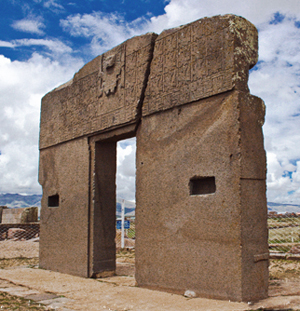 pottery. It seems that Pariti island was an important ceremonial center where the best pottery was sacrificed to the gods, and following an elaborate ritual, broken into pieces to be buried. Tonight, visit the Alaphacha Observatory to learn about the Andean Sky and to observe with the 22" StarMaster public telescope. (B, D) pottery. It seems that Pariti island was an important ceremonial center where the best pottery was sacrificed to the gods, and following an elaborate ritual, broken into pieces to be buried. Tonight, visit the Alaphacha Observatory to learn about the Andean Sky and to observe with the 22" StarMaster public telescope. (B, D)
July 5, Today, we visit the impressive and enigmatic site of the Tiwanacu Sun Temple. Pre-dating the Incan empire, the Temple represents an era of thriving livelihood and culture in the high altiplano where arts and sciences were studied. Inhabitants during the Tiwanacu period revered the sun and moon as well as mother earth. The two pyramids and underground sun temple reveal a critically accurate understanding of astronomy in order to accomplish accurate positioning for equinox alignments. Tonight, visit the Kallawaya medicine man. We will learn about the pharmacology of the Andean people through ancient traditions. (B, D)
July 6, Inca Utama Resort Complex is home to the Limachi family. As makers of the Ra for explorer Thor Heyerdahl, the Limachi family will demonstrate construction of the reed boats used to cross the atlantic ocean on his voyage. Today, we visit Isla del Sol, at the heart of Andean Archeo-Astronomy. This was the birthplace of the Incan Sun God and still considered to be the most sacred place of the ancient people. There are over 180 ruins on the island. Most of these date to the Inca period circa the 15h century CE. Archaeologists have discovered evidence that people lived on the island as far back as the third millennium BCE. We climb the island's steps to visit the sacred fountain. We will also visit Isla de la Luna before returning to the resort for more incredible nighttime observing. (B, L, D)
July 7, 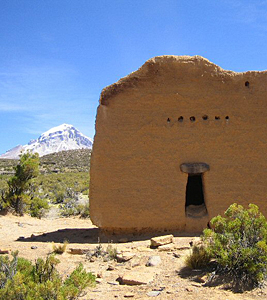 Today we transfer by road from La Paz to Chile. Our route will bring us through the depths of the Andean summits under the shadow of Sajama, Bolivia's highest mountain. We will travel through time in the barren and beautiful Atacama desert, where ancient burial Chulpas litter the epic landscape under a vivid azure sky. This landscape is among some of the most undistrurbed in the world. Along our way we pass through the Chilean Parque Nacional Lauca. This park is well-known for being home to a great wealth of flora and fauna and its highly interesting cultural, historical and wild beauty sites. A major attraction of the park is the astonishing Chungara Lake, one of the most elevated of the world, located at the foot of the Payachata twin volcanoes. Tonight, we are back to sea level in Arica, Chile. (B, D) Today we transfer by road from La Paz to Chile. Our route will bring us through the depths of the Andean summits under the shadow of Sajama, Bolivia's highest mountain. We will travel through time in the barren and beautiful Atacama desert, where ancient burial Chulpas litter the epic landscape under a vivid azure sky. This landscape is among some of the most undistrurbed in the world. Along our way we pass through the Chilean Parque Nacional Lauca. This park is well-known for being home to a great wealth of flora and fauna and its highly interesting cultural, historical and wild beauty sites. A major attraction of the park is the astonishing Chungara Lake, one of the most elevated of the world, located at the foot of the Payachata twin volcanoes. Tonight, we are back to sea level in Arica, Chile. (B, D)
July 8-9, Today, we have a city tour of Arica. We will explore the city of Arica and its archaeology, museums and villages to see ancient geoglyphs and the famous Chinchorro mummies. We visit Valley of Azapa to reach the surprising panels of Cerro Sombrero and Cerro Sagrado with all their Andean view of the world through the giant petroglyphs. After dinner, we take a late night flight Arica to Santiago, Chile.
A safety day is scheduled in our itinerary at this time for flexibility of pending LAN flight schedules. (B, D)
Overnight in Arica or Santiago TBD.
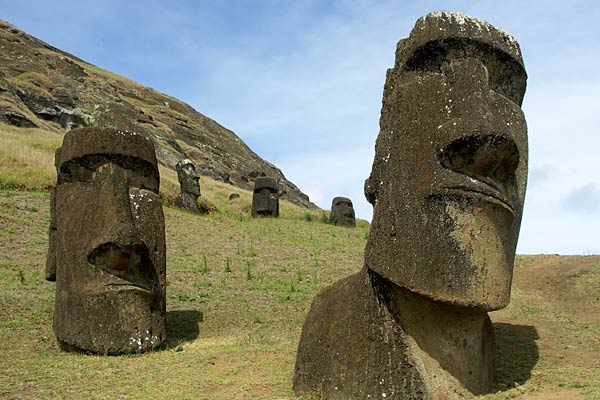 July 10, Early morning flight Santiago, Chile to Easter Island LA 841 L 10JUL SCL-IPC 0820 - 1210 July 10, Early morning flight Santiago, Chile to Easter Island LA 841 L 10JUL SCL-IPC 0820 - 1210
Arrival and Check in to Hotel. Afternoon: Archeological Museum, Ceremonial Complex of Ahu Thai, the cave of Ana Kai Tangata Departure from the hotel, to visit the Archeological Museum of Sebastian Englert. This museum contains interesting graphics and drawings which ilustrate the Rapa Nui Culture. In the Surroundings of Hanga Roa we will visit the ramp of Tahai, a houseboat Hare Paenga and the lonely standing Moai Kote Riku with his hat made of reddish stone Pijau. We continue along the coast up to the cave Ana Kai Tangata, which is situated very near a slope. Inside the cave we can find drawings of birds. Return to the hotel. (B, D)
July 11, Eclipse Day! Our duration at the proposed approximate site is 4:37 (subject to change).
Ahu Akivi Teple, the cave of Te Pahu and the quarry of Puna Pau Departure from the hotel to go to the center of the island to visit the temple Ahu Akivi, or 7 Moais. The platform is decorated with small stones which were found at the shore, remnants of a ship that sank during the last century. Some banana plants nearby indicate that we are near the cave of Te Pahu, which is one of the largest on the island. People say that one can go inside up to 150 mts. We will continue towards the quarries of Puna Pau, an archeological center, were in old times the moai's hats were sculptured out of redish colored stone. Return to the hotel. Then, we head to our specially selected observing location for first contact at 12:40pm. Totality starts at 2:08pm and fourth contact is at 3:34pm. Afterwards, return to the hotel for a celebration dinner. (B, D)
July 12, Full day Touring: Ahu Vaihu, Akahanga, Tongariki, quarry of Rano Raraku, Te 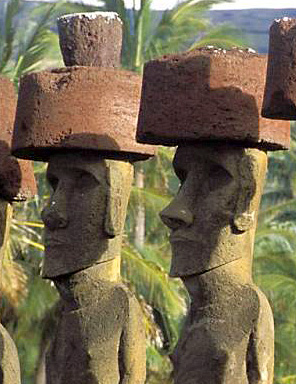 Pito Kura, Nau Nau and Anakena Beach. Departure from the hotel to go to Vaihu. This temple must have lived a serious crisis, which caused the destruction of the Moais and their red hats thrown into the ocean. We continue along the east coast until reaching Akahanga, a platform which is supposed to be situated very near the place where King Hotu Matua was buried. We continue towards Tongariki, an impressive platform composed by 15 moais. They have been restored during 1992 and 1994 with the help of international scientists and financial help of Japan and other countries. You can find a great number of petroglyphs nearby. We continue to the bottom of the Rano Raraku volcano. In the quarries of this volcano many of the Moais were sculptured, as we can still appreciate the scultured stones. You can ascend the volcano to observe the immense crater. Those who get to the top have a marvellous view on the ocean and the lagoon with its bed of bulrush. During the Rapa Nui Festival ancient competitions are realized just as in the old days. We now will visit Tepito Kura, a platform with the largest Moai, who is standing all on its own, Nau Nau is a temple very near Anakena beach, which was restored between the years 1978 and 1979. It possesses the best conserved statues. After this we arrive at Anakena, a beautiful beach in Polynesian style. You will have a picnic lunch and afterwards leisure time. Return to the hotel by the main road. Arrival at the hotel in the afternoon. (B) Pito Kura, Nau Nau and Anakena Beach. Departure from the hotel to go to Vaihu. This temple must have lived a serious crisis, which caused the destruction of the Moais and their red hats thrown into the ocean. We continue along the east coast until reaching Akahanga, a platform which is supposed to be situated very near the place where King Hotu Matua was buried. We continue towards Tongariki, an impressive platform composed by 15 moais. They have been restored during 1992 and 1994 with the help of international scientists and financial help of Japan and other countries. You can find a great number of petroglyphs nearby. We continue to the bottom of the Rano Raraku volcano. In the quarries of this volcano many of the Moais were sculptured, as we can still appreciate the scultured stones. You can ascend the volcano to observe the immense crater. Those who get to the top have a marvellous view on the ocean and the lagoon with its bed of bulrush. During the Rapa Nui Festival ancient competitions are realized just as in the old days. We now will visit Tepito Kura, a platform with the largest Moai, who is standing all on its own, Nau Nau is a temple very near Anakena beach, which was restored between the years 1978 and 1979. It possesses the best conserved statues. After this we arrive at Anakena, a beautiful beach in Polynesian style. You will have a picnic lunch and afterwards leisure time. Return to the hotel by the main road. Arrival at the hotel in the afternoon. (B)
July 13, Cave of Ana Kakenga, Te Pora, Maunga, Terevaka and the beach of Ovahe. We will go to the north coast visiting the cave of Ana Kakenga, which is also known as the cave of two windows. Going through a small tunnel, you reach a small room, situated on top of the cliffs. The two holes or windows offer a spectacular view on the ocean and the small island of Motu Tautara. We carry on towards the cave Te Pora and the highest point of the island, Maunga Terevaka, 560 mts. From this viewpoint you have a fantastic view on the whole island, the ocean and the 360 horizon. The excursion finishes with a little rest at Ovahe beach, which is very near Anakena beach. Return to the hotel. The visit to Maunga Terevaka is subject to confirmation due to the conditions of the road and also due to local restrictions to avoid the erosion of the soil. (B)
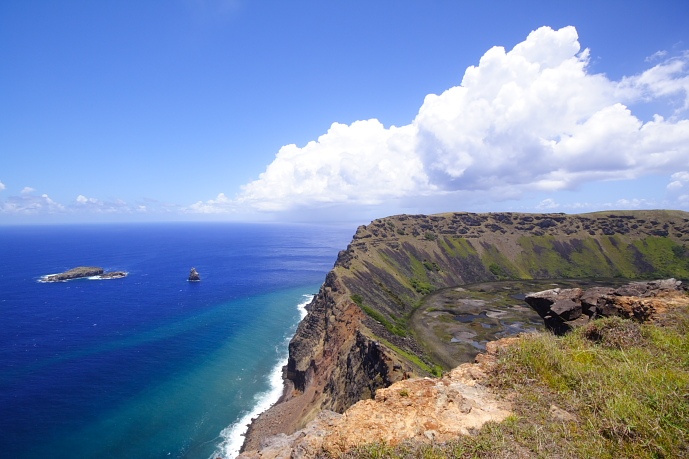
July 14, (B,D)
Early this morning, we visit Volkano Rano Kao, Ceremonial Village Orongo and Temple of Vinapu. We depart from the hotel heading south. The road leads along the coast line up to the administration headquarters of the Orongo National Park, where we find the volcano Rano Kao whose crater has a diameter of 1.6 km and a depth of 200 mts. It is covered with a thick bulrush vegetation. During a spectacular walk along the crater on our left hand side and the Pacific Ocean on our right, we will discover Orongo, a ceremonial center and fortress which possesses the greatest concentration of petroglyphs. We can have a look at the Motus, islets, Motu Iti, Motu Nui and Motu Kao Kao, where the ceremonies in honor of the Birdman and other Gods took place. The excursion finishes visiting Vinapu. As this temple counts with extraordinary stone works, it makes us think that the ancient Incas colonized the island. (B)
July 15, 2010 Check out and transfer to airport for departure. (B)
LA 834 L 15JUL 4 IPCSCL HK10 1100 1745 *1A/E*
|


 pottery. It seems that Pariti island was an important ceremonial center where the best pottery was sacrificed to the gods, and following an elaborate ritual, broken into pieces to be buried. Tonight, visit the Alaphacha Observatory to learn about the Andean Sky and to observe with the 22" StarMaster public telescope. (B, D)
pottery. It seems that Pariti island was an important ceremonial center where the best pottery was sacrificed to the gods, and following an elaborate ritual, broken into pieces to be buried. Tonight, visit the Alaphacha Observatory to learn about the Andean Sky and to observe with the 22" StarMaster public telescope. (B, D) Today we transfer by road from La Paz to Chile. Our route will bring us through the depths of the Andean summits under the shadow of Sajama, Bolivia's highest mountain. We will travel through time in the barren and beautiful Atacama desert, where ancient burial Chulpas litter the epic landscape under a vivid azure sky. This landscape is among some of the most undistrurbed in the world. Along our way we pass through the Chilean Parque Nacional Lauca. This park is well-known for being home to a great wealth of flora and fauna and its highly interesting cultural, historical and wild beauty sites. A major attraction of the park is the astonishing Chungara Lake, one of the most elevated of the world, located at the foot of the Payachata twin volcanoes. Tonight, we are back to sea level in Arica, Chile. (B, D)
Today we transfer by road from La Paz to Chile. Our route will bring us through the depths of the Andean summits under the shadow of Sajama, Bolivia's highest mountain. We will travel through time in the barren and beautiful Atacama desert, where ancient burial Chulpas litter the epic landscape under a vivid azure sky. This landscape is among some of the most undistrurbed in the world. Along our way we pass through the Chilean Parque Nacional Lauca. This park is well-known for being home to a great wealth of flora and fauna and its highly interesting cultural, historical and wild beauty sites. A major attraction of the park is the astonishing Chungara Lake, one of the most elevated of the world, located at the foot of the Payachata twin volcanoes. Tonight, we are back to sea level in Arica, Chile. (B, D) July 10, Early morning flight Santiago, Chile to Easter Island LA 841 L 10JUL SCL-IPC 0820 - 1210
July 10, Early morning flight Santiago, Chile to Easter Island LA 841 L 10JUL SCL-IPC 0820 - 1210  Pito Kura, Nau Nau and Anakena Beach. Departure from the hotel to go to Vaihu. This temple must have lived a serious crisis, which caused the destruction of the Moais and their red hats thrown into the ocean. We continue along the east coast until reaching Akahanga, a platform which is supposed to be situated very near the place where King Hotu Matua was buried. We continue towards Tongariki, an impressive platform composed by 15 moais. They have been restored during 1992 and 1994 with the help of international scientists and financial help of Japan and other countries. You can find a great number of petroglyphs nearby. We continue to the bottom of the Rano Raraku volcano. In the quarries of this volcano many of the Moais were sculptured, as we can still appreciate the scultured stones. You can ascend the volcano to observe the immense crater. Those who get to the top have a marvellous view on the ocean and the lagoon with its bed of bulrush. During the Rapa Nui Festival ancient competitions are realized just as in the old days. We now will visit Tepito Kura, a platform with the largest Moai, who is standing all on its own, Nau Nau is a temple very near Anakena beach, which was restored between the years 1978 and 1979. It possesses the best conserved statues. After this we arrive at Anakena, a beautiful beach in Polynesian style. You will have a picnic lunch and afterwards leisure time. Return to the hotel by the main road. Arrival at the hotel in the afternoon. (B)
Pito Kura, Nau Nau and Anakena Beach. Departure from the hotel to go to Vaihu. This temple must have lived a serious crisis, which caused the destruction of the Moais and their red hats thrown into the ocean. We continue along the east coast until reaching Akahanga, a platform which is supposed to be situated very near the place where King Hotu Matua was buried. We continue towards Tongariki, an impressive platform composed by 15 moais. They have been restored during 1992 and 1994 with the help of international scientists and financial help of Japan and other countries. You can find a great number of petroglyphs nearby. We continue to the bottom of the Rano Raraku volcano. In the quarries of this volcano many of the Moais were sculptured, as we can still appreciate the scultured stones. You can ascend the volcano to observe the immense crater. Those who get to the top have a marvellous view on the ocean and the lagoon with its bed of bulrush. During the Rapa Nui Festival ancient competitions are realized just as in the old days. We now will visit Tepito Kura, a platform with the largest Moai, who is standing all on its own, Nau Nau is a temple very near Anakena beach, which was restored between the years 1978 and 1979. It possesses the best conserved statues. After this we arrive at Anakena, a beautiful beach in Polynesian style. You will have a picnic lunch and afterwards leisure time. Return to the hotel by the main road. Arrival at the hotel in the afternoon. (B)